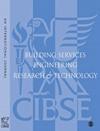A revised PMV model: From a physiological standpoint
IF 1.8
4区 工程技术
Q3 CONSTRUCTION & BUILDING TECHNOLOGY
Building Services Engineering Research & Technology
Pub Date : 2023-07-25
DOI:10.1177/01436244231191244
引用次数: 0
Abstract
In the field of thermal comfort, the adaptive approach is widely used. However, the current main adaptive models correlate thermal comfort with outdoor temperature, and the PMV model is only concerned with behavioural adaptation. The purpose of this paper is to develop a revised PMV (rPMV) model that can account for both behavioural and psychological adaptation. From a physiological standpoint, psychological adaptation affects the actual neutral skin temperature and actual sensitivity to thermal load change, whereas these two parameters used in the PMV model have no relation to psychological adaptation. When using the actual neutral skin temperature and actual sensitivity to thermal load change, the rPMV model can thus account for both psychological and behavioural adaptation. The actual neutral skin temperatures and sensitivities for Shanghai residents in the autumn, as well as Nanjing residents in the summer and winter, were calculated using data from field experiments that measured environmental parameters and investigated thermal sensation. The results show that the rPMV model significantly improves thermal sensation prediction accuracy compared to the PMV model. According to the findings, the rPMV model can be used to create an energy-efficient and comfortable indoor environment. Practical applications: The thermal comfort prediction model assesses indoor climate, which has a significant impact on building energy consumption and thus its sustainability. The use of a good prediction model is critical to the success of building design. This paper develops a thermal comfort prediction model that can not only accurately predict thermal comfort of building occupant but also be used to design sustainable buildings.一个修正的PMV模型:从生理学的角度
在热舒适领域,自适应方法得到了广泛的应用。然而,目前的主要自适应模型将热舒适性与室外温度联系起来,PMV模型只关注行为适应。本文的目的是开发一个修正的PMV(rPMV)模型,该模型可以考虑行为和心理适应。从生理学的角度来看,心理适应影响实际的中性皮肤温度和对热负荷变化的实际敏感性,而PMV模型中使用的这两个参数与心理适应无关。因此,当使用实际中性皮肤温度和对热负荷变化的实际敏感性时,rPMV模型可以考虑心理和行为适应。使用现场实验的数据计算了上海居民秋季以及南京居民夏季和冬季的实际中性皮肤温度和敏感性,这些实验测量了环境参数并调查了热感。结果表明,与PMV模型相比,rPMV模型显著提高了热感预测的准确性。根据研究结果,rPMV模型可以用来创造一个节能舒适的室内环境。实际应用:热舒适性预测模型评估室内气候,这对建筑能耗及其可持续性有重大影响。良好的预测模型的使用对建筑设计的成功至关重要。本文开发了一个热舒适性预测模型,该模型不仅可以准确预测建筑使用者的热舒适性,而且可以用于可持续建筑的设计。
本文章由计算机程序翻译,如有差异,请以英文原文为准。
求助全文
约1分钟内获得全文
求助全文
来源期刊

Building Services Engineering Research & Technology
工程技术-结构与建筑技术
CiteScore
4.30
自引率
5.90%
发文量
38
审稿时长
>12 weeks
期刊介绍:
Building Services Engineering Research & Technology is one of the foremost, international peer reviewed journals that publishes the highest quality original research relevant to today’s Built Environment. Published in conjunction with CIBSE, this impressive journal reports on the latest research providing you with an invaluable guide to recent developments in the field.
 求助内容:
求助内容: 应助结果提醒方式:
应助结果提醒方式:


